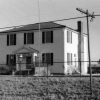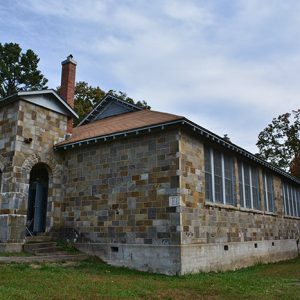calsfoundation@cals.org
Ozone School
The Ozone School was built by the Works Projects Administration (WPA) to serve part of rural Johnson County. It was listed on the National Register of Historic Places in 2015.
European settlement began in the area of Ozone (Johnson County) in the early 1800s, specifically with the arrival of Major M. Gillian and Kate Gillian (sometimes spelled Gillion) in 1840. A post office was established in Ozone in 1873. The earliest schools in Johnson County were called “pay schools.” Classes were often held in private homes, and the teachers were usually itinerants. In the first part of the twentieth century, school in the Ozone area was held in a small building that also served as the Methodist church. However, by the late 1930s or early 1940s, it became necessary to build a new school. Plans for constructing a new school by the Works Progress Administration were announced in December 1941.
Construction of the Ozone School continued throughout the year at a feverish pace in order to have the building ready for the beginning of the school year in the fall. In September, it was reported that “work on [the] new school building is progressing nicely.” By October, the building was completed, and the school year began in the new building on October 26, 1942. Even though the building was opened for classes in October, the building’s dedication was not held until December.
The Ozone School rests on a continuous cast-concrete foundation and has cut-stone walls. The building’s fenestration consists of large, nine-over-nine, wood-frame, double-hung windows. Projecting porches with gable roofs are located at the east and west ends of the building. The building is topped by a gable-on-hip roof that is covered in asphalt shingles. The interior of the building consists of a central hallway with classrooms on each side. All of the walls have original beadboard paneling on the bottom part and original horizontal board paneling on the upper portion. The floors are narrow hardwood and the ceilings are covered in acoustical tile. Some of the rooms, along with the hall, have built-in wooden cabinets, which are also original to the building.
By 1957, it was reported that “the school at Ozone has one teacher for about fifteen pupils enrolled in the first grade through the sixth grade.” In late August, it was decided that the Ozone school would close, along with the school at Hagarville (Johnson County). Once Ozone’s school district consolidated with that of Lamar (Johnson County), the Ozone School was donated to the Ozone community, and a board of three trustees was set up to oversee the building’s care. The building has remained an important part of the community’s life through various meetings and fundraisers, elections, and reunions. It also houses the local library and a closet that offers free clothing for the needy.
For additional information:
“Hagarville and Ozone Schools to Be Discontinued.” Johnson County Weekly Graphic, August 29, 1957, p. 1.
Langford, Ella Molloy. History of Johnson County, Arkansas: The First Hundred Years. Clarksville, AR: Johnson County Historical Society, 1992.
“Ozone Has New School Building.” Clarksville Herald-Democrat, October 15, 1942, p. 1.
“Ozone School.” National Register of Historic Places nomination form. On file at Arkansas Historic Preservation Program, Little Rock, Arkansas.
“Ozone School Has Dedication Program Dec. 19.” Clarksville Herald-Democrat, December 21, 1942, p. 1.
“Ozone Schools Opened Monday.” Clarksville Herald-Democrat, October 29, 1942, p. 1.
“Supervisor Cites Education’s Cost.” Johnson County Weekly Graphic, February 21, 1957, p. 1.
“WPA Officials Announce Plans For Ozone School.” Clarksville Herald-Democrat, December 18, 1941, p. 1.
Yates, Lois Best. Ozone School: Our Heritage. Privately printed. On files at Arkansas Historic Preservation Program, Little Rock, Arkansas
Ralph S. Wilcox
Arkansas Historic Preservation Program
 Architectural Styles
Architectural Styles Education, Elementary and Secondary
Education, Elementary and Secondary Historic Preservation
Historic Preservation World War II through the Faubus Era, 1941 through 1967
World War II through the Faubus Era, 1941 through 1967 Ozone School
Ozone School 




Comments
No comments on this entry yet.